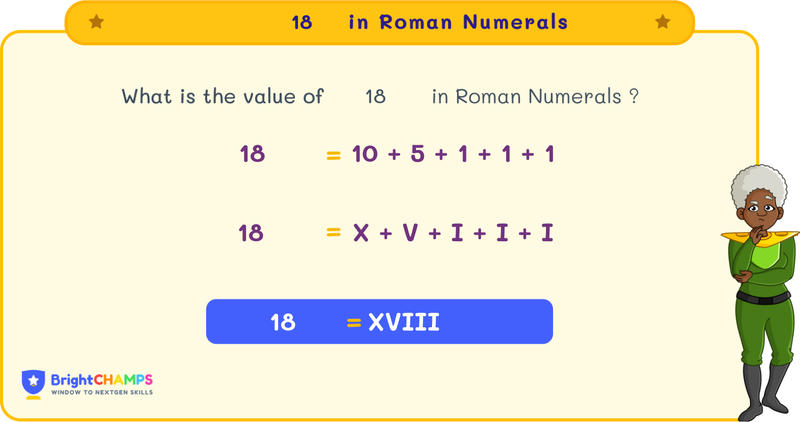Summarize this article:
 279 Learners
279 LearnersLast updated on August 5, 2025
18 in Roman Numerals

Roman numerals are a way of expressing numbers using symbols. I, V, X, L, C, D, and M are the symbols we use. Roman Numerals are used in royal titles, book names, sequences, and so on. Here we will be discussing Roman Numerals, rules, and examples.

What is 18 in Roman Numerals?
The royal titles, such as Henry I, Henry II, and so on. Have you noticed the names and wondered what these symbols (I and II) represented? Those are the Roman Numerals. Earlier people used to count using fingers, sticks, bones, etc., to count. When life became complex, a standard form was required to count. Ancient Romans used the Roman Numeral system to count. I (1), V (5), X (10), L (50), C (100), D (500), and M (1000) are the symbols we use to count.
In Roman Numerals, we use XVIII to represent 18, here X is 10, V is 5, and III is 3. Let’s learn more about Roman Numerals and how we write them.


Basic Rules for 18 in Roman Numerals
There are certain basic rules to write a number in Roman Numerals. In this section, let’s discuss some basic rules that need to be remembered when writing a number in Roman numerals.
Rule 1: Addition Method
The addition method is used when the smaller number is placed after the larger number, then it is the addition method. For example, XVIII → X + V + III → 10 + 5 + 3 = 18
Rule 2: Repetition Method
To write a large number, there are certain Roman Numerals that can be repeated up to three times. III → 3.
Rule 3: Subtraction Method
If a small number is followed by a large number in Roman Numerals, we subtract the smaller number from the large number; it is a subtraction method. For example, IX → X - I → 10 - 1 = 9
Rule 4: Limitation Rule
The symbols cannot be repeated more than three times, and some symbols like V, L, and D cannot be repeated. For example, we won't write VV for 10; instead, we use X. For 8, we write VIII, not IIIIIIII.

How to Write 18 in Roman Numerals
Let’s now learn how to write 18 in Roman Numerals. Follow these methods to write the number in Roman Numerals.
By Expansion Method
By Grouping Method
Explore Our Programs



18 in Roman Numeral by Expansion Method
In the expansion method, based on the place value, the number is broken down. In this section, we will learn how to write 18 in Roman numerals using the expansion method.
To write 18 in Roman Numerals, follow the steps:
Step 1: The number is broken based on the place value. Place value that is ones, tens, hundreds, etc.
For 18, we write it as 10 + 5 + 3.
Step 2: Converting the number into Roman Numerals
10 in Roman Numerals — X
5 in Roman Numerals — V
3 in Roman Numerals — III
Step 3: Combining the Roman Numerals together.
Therefore, 18 in Roman Numerals is X (10) + V (5) + III (3) = XVIII

18 in Roman Numeral by Grouping Method
When writing a large number into Roman Numerals, we group the number.
To write 18 in Roman Numerals, we group 18 as 10 + 5 + 3.
10 in Roman Numerals — X
5 in Roman Numerals — V
3 in Roman Numerals — III
So, 18 is written as XVIII in Roman Numerals.

Common Mistakes and How to Avoid Them in 18 Roman Numerals
Students make mistakes when writing a number in Roman Numerals. To master Roman Numerals, we can learn a few common mistakes and the ways to avoid them.

18 in Roman Numerals Examples

Problem 1
A history museum has XVIII artifacts to display each day. If they plan to show these artifacts over IX days, how many artifacts will be displayed each day?

The number of artifacts displayed each day is II.
Explanation
To find how many artifacts are displayed each day, we divide the total number of artifacts by the number of days.
That is XVIII / IX
XVIII = 18
IX = 9
Therefore, XVIII / IX = 18 / 9 = 2.
2 in Roman numerals can be written as II.

Problem 2
A puzzle requires rearranging the letters of "EIGHTEEN" into a grid with VI rows, with the same number of letters in each row. How many letters will each row contain?

Each row will contain III letters.
Explanation
The word "EIGHTEEN" has 8 letters. To find how many letters each row contains, divide the total number of letters by the number of rows.
VIII / VI = 8 / 6 = 1 remainder 2.
Since the grid must be filled evenly, each full row will have III letters, and two additional rows will have one extra letter each.

Problem 3
Calculate the sum of the Roman numerals IX and IX.

The sum of IX and IX is XVIII.
Explanation
Sum is the result of adding two numbers.
IX = 9
IX = 9
9 + 9 = 18
18 in Roman Numerals is XVIII.
The sum of IX and IX is XVIII.

Problem 4
What is the difference between XX and II?

The difference between XX and II is XVIII.
Explanation
The difference of two numbers is the value we get when subtracting one number from another.
XX = 20
II = 2
20 - 2 = 18
18 in Roman Numerals can be written as XVIII.

Problem 5
Write the Roman Numeral for 9 + 9 using the expansion method.

The Roman numeral for 9 + 9 is XVIII.
Explanation
First convert the numbers 9 and 9 into Roman numerals.
9 - IX
9 - IX
Add the numbers together: 9 + 9 = 18
Using the expansion method: 18 = 10 + 8 = XVIII.


FAQs on 18 in Roman Numerals
1.What is 9 in Roman numerals?
2.How to write 18 in Roman numerals?
3.What is 16 in Roman Numerals?
4.Is XVIII a prime number?
5.What are the multiples of 18?

Important Glossaries for 18 in Roman Numerals
- Addition rule: Addition method is used when a large number is followed by a smaller numeral; here the values are added. For example, XVIII = X + V + III = 10 + 5 + 3 = 18.
- Grouping method: Here the given numbers are grouped based on their place value, and then we convert each group into its Roman numerals. For example, 18 = 10 + 5 + 3 = XVIII.
- Repetition rule: Certain symbols (I, X, C, M) in the Roman numeric system can be repeated only up to three times. For example, III = 3 (I is repeated three times to represent the number 3).
- Subtraction rule: Subtraction method is used when a smaller number is placed before a larger numeral. For example, IX = X - I = 10 - 1 = 9.
- Roman Numeral symbols: The symbols used in the Roman numeral system are I (1), V (5), X (10), L (50), C (100), D (500), and M (1000).



Hiralee Lalitkumar Makwana
About the Author
Hiralee Lalitkumar Makwana has almost two years of teaching experience. She is a number ninja as she loves numbers. Her interest in numbers can be seen in the way she cracks math puzzles and hidden patterns.
Fun Fact
: She loves to read number jokes and games.

















